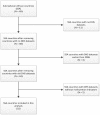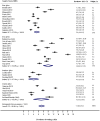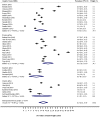Child malnutrition in sub-Saharan Africa: A meta-analysis of demographic and health surveys (2006-2016)
- PMID: 28494007
- PMCID: PMC5426674
- DOI: 10.1371/journal.pone.0177338
Child malnutrition in sub-Saharan Africa: A meta-analysis of demographic and health surveys (2006-2016)
Abstract
Background: Sub-Saharan Africa has one of the highest levels of child malnutrition globally. Therefore, a critical look at the distribution of malnutrition within its sub-regions is required to identify the worst affected areas. This study provides a meta-analysis of the prevalence of malnutrition indicators (stunting, wasting and underweight) within four sub-regions of sub-Saharan Africa.
Methods: Cross-sectional data from the most recent Demographic and Health Surveys (2006-2016) of 32 countries in sub-Saharan Africa were used. The countries were grouped into four sub-regions (East Africa, West Africa, Southern Africa and Central Africa), and a meta-analysis was conducted to estimate the prevalence of each malnutrition indicator within each of the sub-regions. Significant heterogeneity was detected among the various surveys (I2 >50%), hence a random effect model was used, and sensitivity analysis was performed, to examine the effects of outliers. Stunting was defined as HAZ<-2; wasting as WHZ<-2 and underweight as WAZ<-2.
Results: Stunting was highest in Burundi (57.7%) and Malawi (47.1%) in East Africa; Niger (43.9%), Mali (38.3%), Sierra Leone (37.9%) and Nigeria (36.8%) in West Africa; Democratic Republic of Congo (42.7%) and Chad (39.9%) in Central Africa. Wasting was highest in Niger (18.0%), Burkina Faso (15.50%) and Mali (12.7%) in West Africa; Comoros (11.1%) and Ethiopia (8.70%) in East Africa; Namibia (6.2%) in Southern Africa; Chad (13.0%) and Sao Tome & Principle (10.5%) in Central Africa. Underweight was highest in Burundi (28.8%) and Ethiopia (25.2%) in East Africa; Niger (36.4%), Nigeria (28.7%), Burkina Faso (25.7%), Mali (25.0%) in West Africa; and Chad (28.8%) in Central Africa.
Conclusion: The prevalence of malnutrition was highest within countries in East Africa and West Africa compared to the WHO Millennium development goals target for 2015. Appropriate nutrition interventions need to be prioritised in East Africa and West Africa if sub-Saharan Africa is to meet the WHO global nutrition target of improving maternal, infant and young child nutrition by 2025.
Conflict of interest statement
Figures




References
-
- UNICEF. State of the World’s Children Statistical Report. 2015
-
- Leroy JL, Ruel M, Habicht JP, Frongillo EA. Linear growth deficit continues to accumulate beyond the first 1000 days in low-and middle-income countries: global evidence from 51 national surveys. The Journal of nutrition. 2014. September 1; 144(9):1460–6. doi: 10.3945/jn.114.191981 - DOI - PubMed
-
- UNICEF. Improving child nutrition: the achievable imperative for global progress. New York: UNICEF; 2013. April.
-
- Black RE, Victora CG, Walker SP, Bhutta ZA, Christian P, De Onis M, et al. Maternal and child undernutrition and overweight in low-income and middle-income countries. The Lancet. 2013. August 9; 382(9890):427–51. - PubMed
Publication types
MeSH terms
LinkOut - more resources
Full Text Sources
Other Literature Sources
Medical

